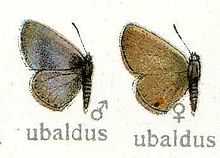Azanus ubaldus
| Bright Babul Blue | |
|---|---|
 | |
| at Bangalore, India | |
| Scientific classification | |
| Kingdom: | Animalia |
| Phylum: | Arthropoda |
| Class: | Insecta |
| Order: | Lepidoptera |
| Family: | Lycaenidae |
| Genus: | Azanus |
| Species: | A. ubaldus |
| Binomial name | |
| Azanus ubaldus (Stoll, [1782])[1] | |
| Synonyms | |
| |
| Wikimedia Commons has media related to Azanus ubaldus. |
The Bright Babul Blue, Desert Babul Blue, or Velvet-spotted Blue[2] (Azanus ubaldus) is a small butterfly found in India, the Middle East and Africa that belongs to the Lycaenids or Blues family.
Description

Male upperside brownish purple, dark blue at base of wings. Fore wing: costa very narrowly along its apical half, ternien evenly and a little more broadly from apex to tornus, edged with brown; the area on the disc, in the cell and beyond it is covered with hair-like specialized scales and is distinctly darker. Hind wing: similar, the brown edging to the costa much broader; posteriorly in the tornal area there is a dark spot in interspace 1 and another more clearly defined similar spot in interspace 2, both spots merged more or less into the terminal brown edging. Cilia of both fore and hind wings white, with their basal halves evenly dark brown. Underside: greyish brown. Fore wing: two short white lines, one each side of the discocellulars; a minute black subcostal dot above apex of cell, another similar dot a little beyond it; two parallel, obliquely placed, transverse, upper discal white lines, followed by an inner aud an outer obliquely placed, irregular, broken, subterminal line also white, the inner one somewhat lunular, and an anticiliary dark line; the posterior third from base of the wing uniform, somewhat paler than the rest. Hind wing: the following black white-encircled spots conspicuous: 4 subbasal spots in transverse order, a subcostal spot in middle of interspace 7, two minute geminate spots at the tornal angle, and a larger one in interspace 2; two transverse short white lines on either side of the discocellulars as on the fore wing; a transverse, curved, catenolated, discal band of white markings, followed by a postdiscal and subterminal series of white lunules and an anticiliary dark line edged inwardly with white. Antennae dark brown, the shafts ringed with white; apex of club also white; head, thorax and abdomen dark brown, the thorax in fresh specimens with a little purplish-blue pubescence; beneath: palpi, thorax, and abdomen white.
Female upperside: rich silky brown. Fore and hind wings: suffused with purplish blue at base, and with anticiliary black lines. Hind wing: with two black spots at tornal area as in the male. Underside: as in the male but the markings more regular, more evenly and neatly defined, and the white transverse lines on the fore wing carried to the dorsal margin. Cilia, antennae, head, thorax and abdomen similar to those of the male, the thorax however, devoid of any bluish pubescence on the upperside.[3]
See also
References
- ↑ Azanus, Site of Markku Savela
- ↑ Woodhall, Steve. Field Guide to Butterflies of South Africa, Cape Town:Struik Publishers, 2005.
- ↑ Bingham, C. T. 1907. Fauna of British India. Butterflies. Volume 2